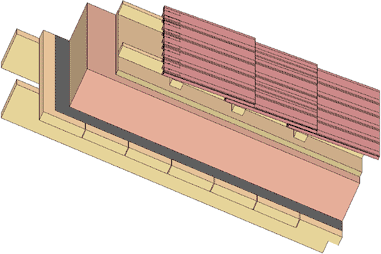Geprüftes/zugelassenes Bauteil
pitched roof sdshzx01-05
pitched roof exposed rafter, ventilated, -, without lining
Building physical assessment
| Fire performance | REI | 30 |
|---|---|---|
|
maximum span = 5 m; maximum load Ed,fi = 5,29 kN/m² (with exposed beams 180/240 and fire protection cladding)
Classified by HFA Classified by HFA
Fire performance Germany
Classification: F30
Load Ed,fi according to the German certification document
Proof: DIN 4102-4:2016-05, Tabelle 10.24, Zeile 1
|
||
| Thermal performance | U | 0,14 W/(m2K) |
| Diffusion | adequate | |
|
Calculated by TUM
|
||
| Acoustic performance | Rw (C;Ctr) | 44 dB (-3; -8) |
| Ln,w (Cl) | ||
|
Rating by Müller-BBM
|
||
| Mass per unit area | m | 137,5 kg/m2 |
data sheet pitched roof
sdshzx01-05 (pdf, 250 KB)
Note
The design of the under-roof construction and of the counter-battens have to be specified according to the roof pitch and the national requirements.
Only for registered members after logging in.


Register of building materials used for this application, cross-section (from outside to inside)
| Thickness [mm] | Building material | Thermal performance | Reaction to fireklasse EN | ||||
|---|---|---|---|---|---|---|---|
| λ | μ min – max | ρ | c | ||||
| A | concrete roof tile or tiled roof | 2100 | A1 | ||||
| B | 30,0 | spruce wood battens (30/50) | 0,120 | 50 | 450 | 1,600 | D |
| C | 50,0 | spruce wood counter battens (Austria: minimum height 50 mm), Germany 30 mm | 0,120 | 50 | 450 | 1,600 | D |
| D | 22,0 | softboard [045; 250] - rigid underlay | 0,045 | 5 | 250 | 2,100 | E |
| E | 240,0 | wood-fibre insulation board [0,040; R=200] - insulation placed on top of the rafters | 0,040 | 5-7 | 200 | 2,100 | E |
| F | vapour barrier sd≥ 1m | 1000 | |||||
| G | 40,0 | spruce wood tongue and groove, fire protection cladding (Germany minimum 50 mm) | 0,120 | 50 | 450 | 1,600 | D |
| H | construction timber in acc. with structural design | 0,120 | 50 | 450 | 1,600 | D | |
Ecological rating (per m2 construction area)
Details of sustainability rating...
| Global warming potential | Share of renewable Primary Energy | Resources | |||||||||||
|---|---|---|---|---|---|---|---|---|---|---|---|---|---|
| Lifecycle Phase |
GWP-F [kgCO2Äqv.] |
GWP-B [kgCO2Äqv.] |
GWP-T [kgCO2Äqv.] |
PERE [MJ] |
PERM [MJ] |
PERT [MJ] |
PENRE [MJ] |
PENRM [MJ] |
PENRT [MJ] |
AP [kgSO2Äqv.] |
EP [kgPO4Äqv.] |
ODP [kgR11Äqv.] |
POCP [kgEthenÄqv.] |
| A1 - A3 | 60,225 | -133,941 | -73,716 | 192,378 | 1373,158 | 1565,536 | 868,716 | 104,020 | 972,736 | 0,226 | 0,103 | 4.6991569E-6 | 0,044 |
Details of sustainability rating...
| Resources | |||||||||||
|---|---|---|---|---|---|---|---|---|---|---|---|
| Lifecycle Phase |
GWP [kgCO2Äqv.] |
AP [kgSO2Äqv.] |
EP [kgPO4Äqv.] |
ODP [kgR11Äqv.] |
POCP [kgEthenÄqv.] |
PERE [MJ] |
PERM [MJ] |
PERT [MJ] |
PENRE [MJ] |
PENRM [MJ] |
PENRT [MJ] |
| A1 - A3 | -101,899 | 0,153 | 0,033 | 2.26E-6 | 0,036 | 518,002 | 1571,410 | 2089,277 | 910,345 | 72,294 | 982,775 |
| C1 - C4 | 150,852 | 0,010 | 0,001 | 1.3E-7 | 0,001 | 4,072 | -1572,776 | -1568,703 | 46,854 | -64,594 | -17,740 |
| A1 - C4 | 49,619 | 0,164 | 0,035 | 2.39E-6 | 0,036 | 522,771 | -1,366 | 521,271 | 966,333 | 7,700 | 974,168 |
Last update 02.08.2023/hfa.eco2soft